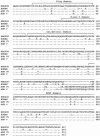Trim5alpha protein restricts both HIV-1 and murine leukemia virus
- PMID: 15249690
- PMCID: PMC490012
- DOI: 10.1073/pnas.0402876101
Trim5alpha protein restricts both HIV-1 and murine leukemia virus
Abstract
Replication of HIV-1 and N-tropic murine leukemia virus (N-MLV) is restricted in a number of different primate cells. In some cell lines, cross-saturation experiments suggest that the two viruses are interacting with the same restriction factor. Recently, Trim5alpha protein from rhesus monkey was found to restrict HIV-1. We have confirmed this result and have shown that Trim5alpha from two African green monkey cell lines, Vero and CV-1, also restricts HIV-1. In addition, we show that human, rhesus, and African green monkey Trim5alpha can restrict N-MLV. By using a panel of MLV capsid mutants, subtle differences in the anti-MLV activity were identified among the different primate Trim5alpha cDNAs. Trim1 isolated from humans and green monkeys was also found to restrict N-MLV. We hypothesize that the Trim family of proteins plays a widespread role in innate immunity to viral infection.
Figures





Comment in
-
In defense of the cell: TRIM5alpha interception of mammalian retroviruses.Proc Natl Acad Sci U S A. 2004 Jul 20;101(29):10496-7. doi: 10.1073/pnas.0404066101. Epub 2004 Jul 13. Proc Natl Acad Sci U S A. 2004. PMID: 15252204 Free PMC article. No abstract available.
References
Publication types
MeSH terms
Substances
Associated data
- Actions
- Actions
- Actions
- Actions
- Actions
- Actions
- Actions
- Actions
LinkOut - more resources
Full Text Sources
Other Literature Sources
Molecular Biology Databases

